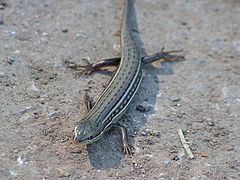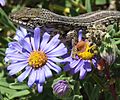Skink facts for kids
Quick facts for kids Skinks |
|
|---|---|
 |
|
| Bridled mabuya, Mabuya vittata | |
| Scientific classification | |
| Kingdom: | |
| Phylum: | |
| Class: | |
| Order: | |
| Suborder: | |
| Infraorder: |
Scincomorpha
|
| Family: |
Scincidae
|
| Subfamilies | |
|
Acontinae |
|
Skinks are a big family of small lizards. They are called the Scincidae family. There are more than 1,500 different species of skinks! This makes them one of the most diverse groups of lizards on Earth. You can find skinks on every continent except Antarctica. They come in many sizes, colors, and shapes, which makes them super interesting to learn about.
Contents
What do Skinks Look Like?
Skinks come in many sizes. The smallest skinks are only a couple of inches long. But some larger species can grow to be over two feet! That's a huge difference! Their body shapes are also very different. Some skinks have long, thin bodies. These are great for squeezing into small spaces. Others have shorter, thicker bodies. These are perfect for digging burrows.
Their legs also vary a lot. Some skinks have strong legs. These help them run and climb well. Others have very tiny legs, or even no legs at all! These legless skinks often look a lot like snakes. But remember, they are still lizards!
Skinks have amazing colors and patterns. You might see skinks that are brown, green, gray, or blue. Some are even bright orange or red! Many have stripes, spots, or other marks. These help them blend in with their surroundings. This special camouflage helps them hide from animals that want to eat them, like birds and snakes. A skink's color and pattern can even change. This depends on its age and the time of year. For example, some skinks get brighter colors during the breeding season. This helps them attract a mate.
Where in the World Do Skinks Live?
Skinks live all over the world, except for Antarctica. They have learned to live in many different places. You can find them in deserts, grasslands, forests, and even mountains. They might live in underground burrows. They also hide under rocks and logs. Some skinks even climb trees! Some skinks like to live near water. Others prefer dry places. The type of place a skink likes depends on its species. For example, the Five-lined Skink (Plestiodon fasciatus) lives in the eastern United States. It likes areas with lots of cover, like leaf piles and old logs. The Broad-headed Skink (Plestiodon laticeps) prefers rocky areas.
What Do Skinks Eat?
Most skinks are insectivores. This means they mainly eat insects. Their diet includes many tasty bugs. These can be crickets, grasshoppers, beetles, and ants. Bigger skinks might also eat spiders, snails, and even other smaller lizards! Some skink species also eat fruits and other plant parts. The size and type of food a skink eats usually depends on its own size. A smaller skink can only eat smaller insects.
Amazing Skink Adaptations
Skinks have developed some cool ways to survive. For example, many skinks can drop their tails. They do this when an animal tries to catch them. This is called caudal autotomy. The tail keeps wiggling. This distracts the animal trying to eat them. The skink then escapes! The tail eventually grows back. But it might not look exactly the same as the first one.
Some skinks also have special scales. These scales help them dig underground. They are often smooth and overlap each other. This lets them move easily through the soil. Other skinks have developed ways to climb. They have strong claws and gripping toes.
Skink Reproduction
Skinks reproduce in different ways. Some species lay eggs. Others give birth to live young. Skinks that lay eggs usually put them in a safe spot. This could be under a rock or in a burrow. The number of eggs can be very different for each species. It can be just a few or over 20 eggs. The time it takes for eggs to hatch also changes. This depends on things like temperature.
For species that give birth to live young, the babies are born fully formed. The number of babies can also be very different.
Skinks and People
Most skinks are not harmful to humans. Many people even keep them as pets. But it's important to remember that all wild animals should be treated with respect. Never try to catch or handle a wild skink unless you are trained to do so. And it's very important to always wash your hands after touching any reptile.
Examples of Different Skinks
Let’s meet a few skinks!
- Five-lined skink (Plestiodon fasciatus): This is a common skink in the eastern United States. It is usually about 6 to 8 inches long. It has five clear light-colored stripes down its back.
- Broad-headed skink (Plestiodon laticeps): This skink lives in the southeastern United States. It is known for its wide head and strong body. Male skinks often have bright orange or red colors during the breeding season.
- Skilton's skink (Plestiodon skiltonianus): This is another North American species. It can live in many places. You can find it in forests and grasslands.
- Blue-tailed skink (Emoia impar): This skink lives in tropical regions. It is famous for its bright blue tail. This tail is especially colorful in males.
- Great-Plains skink (Plestiodon obsoletus): This skink is known for its brownish color. It lives in the plains areas of North America.
Skink Conservation Status
Many skink species are doing well. But some are in danger. They face threats like habitat loss. This happens because of human development and pollution. It's important to protect their homes. This helps make sure these amazing lizards keep thriving. It also helps the whole environment. Many skinks play an important role in their ecosystems by controlling insect populations.
Images for kids
-
A five-lined skink basking on a log in Forest Park.
-
King's skink – Albany, Western Australia
See also
 In Spanish: Escíncidos para niños
In Spanish: Escíncidos para niños










